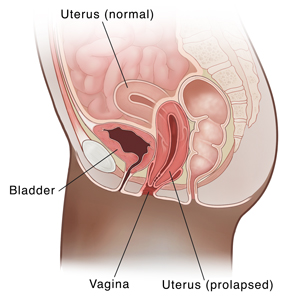Pelvic Prolapse
Pelvic Organ Prolapse
Pelvic organ prolapse is when 1 or more organs inside the pelvis slip from their normal places. The pelvis is found between the waist and thighs. Normally, muscles and tissues in the pelvic region support the pelvic organs and hold them in place.
What is a normal pelvis?

A. The small intestine absorbs nutrients from food.
B. The bladder collects and holds urine.
C. The pubic bone helps protect the pelvic organs.
D. The urethra is the tube that carries urine out of the body.
E. The pelvic floor muscles support organs and other structures in the pelvis.
F. The uterus is where the baby develops when a woman is pregnant.
G. The vagina is the canal from the uterus to the outside of the body.
H. The rectum stores stool until a bowel movement occurs.
What causes pelvic organ prolapse?
There are several causes of pelvic organ prolapse including:
-
Vaginal childbirth
-
Hereditary (genetic) factors
-
Connective tissue disorders
-
Getting older
-
Constant coughing (such as with bronchitis or smoking)
-
Heavy lifting
-
Chronic straining (such as with constipation)
-
Being overweight
What are the symptoms of pelvic organ prolapse?
The symptoms of pelvic organ prolapse include:
-
A feeling of fullness or pressure in your pelvis
-
A sense that a ball or lump is sticking out from the vagina
-
Problems passing urine or having a bowel movement
-
Urine leakage when you cough or use stairs. (But this can happen even without prolapse.)
-
Pain or pressure in your low back
-
Pain when having sex
Nonsurgical Treatment
Pelvic Organ Prolapse: Nonsurgical Treatment
If your pelvic organ prolapse is mild or doesn’t bother you much, or if you have health conditions that make surgery too risky, nonsurgical treatment may be a good choice. A device (pessary) to wear in your vagina can help ease your symptoms. You may also be given certain pelvic floor muscle exercises to do. And you may need to make some lifestyle changes.
Wearing a pessary
A pessary helps support the prolapsed organ or organs. It is specifically fitted by your healthcare provider. A pessary may ease your symptoms, but it can’t repair prolapse. The pessary must be removed for cleaning. If you can’t do this, you will need to see your healthcare provider regularly. They will remove and clean your pessary. If you have questions or concerns about the pessary, be sure to talk with your healthcare provider.
Doing pelvic floor muscle exercises
Simple exercises can help strengthen the pelvic floor muscles. They may ease your symptoms and prevent further prolapse. One simple exercise is done by contracting your pelvic floor muscles as if to stop the urine stream. (Do this when you’re not urinating.) Ask your healthcare provider how many contractions to do and how long to hold each one. During your treatment visits, your healthcare provider may place a device in your vagina to measure your muscle contractions. That way, you can find out if you are doing the exercises correctly.

Other tips
Improving your health may ease your symptoms or keep your problem from getting worse. You may be asked to:
-
Quit smoking to prevent excessive coughing
-
Adjust medicines that may cause urine leakage
-
Limit fluid intake if incontinence is a problem. This includes limiting drinks that contain caffeine (a diuretic). Emptying your bladder at scheduled times (bladder training) also may be useful if you have incontinence.
-
Not do any lifting, which puts pressure on pelvic muscles
-
Exercise and eat well to stay at a healthy weight
Surgery for Uterine Prolapse
Pelvic Organ Prolapse: Surgery for Uterine Prolapse
Risks of surgery
Infection
Bleeding
Risks of anesthesia
Damage to nerves, muscles, or nearby pelvic structures
Blood clots
Prolapse of the pelvic organ or organs happening again
Pain with sex
The surgical procedure
To fix the prolapse, the uterus is often removed. This is called a hysterectomy. Then, the vagina is lifted and supported so it stays in place. This type of surgery can be done through the vagina or abdomen. Stitches are used to attach the vagina to strong tissue in the pelvis. Sometimes a synthetic material or biologic material is used. It reinforces the repair. This supports the top part of the vagina. Other procedures may be done. They will keep the vagina from slipping again. If the uterus is not removed, then the uterus is lifted and supported so it stays in place. There have been some safety concerns with some mesh products. Ask your surgeon if they will be using mesh during your surgery and what the risks may be.
Your incisions
During surgery, the surgeon reaches your pelvic organs through the vagina or the abdomen. If the pelvic organs are reached through the vagina, an incision is made in the wall of the vagina. If the pelvic organs are reached through the abdomen, several small incisions are made in the abdomen to insert tiny laparoscopic tools. Or one larger incision is made in the abdomen. The belly incision can be up and down (vertical) or across (transverse).
